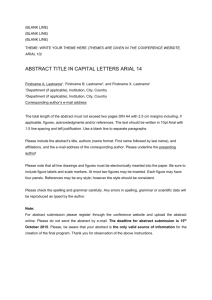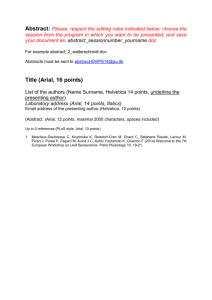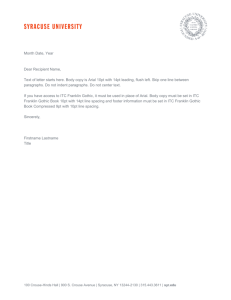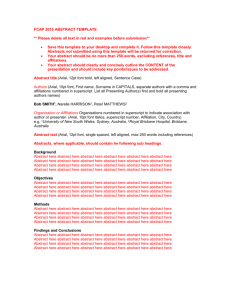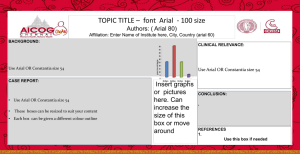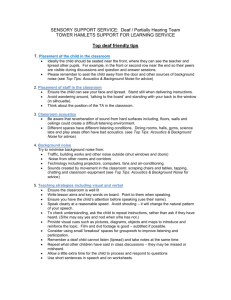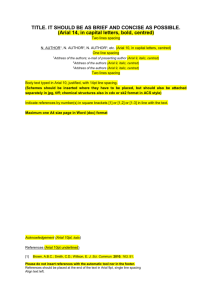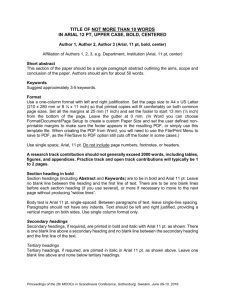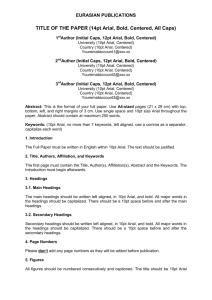SPEECH RESEARCH AT THE UNIVERSITY OF ATLANTIS ##[3
advertisement
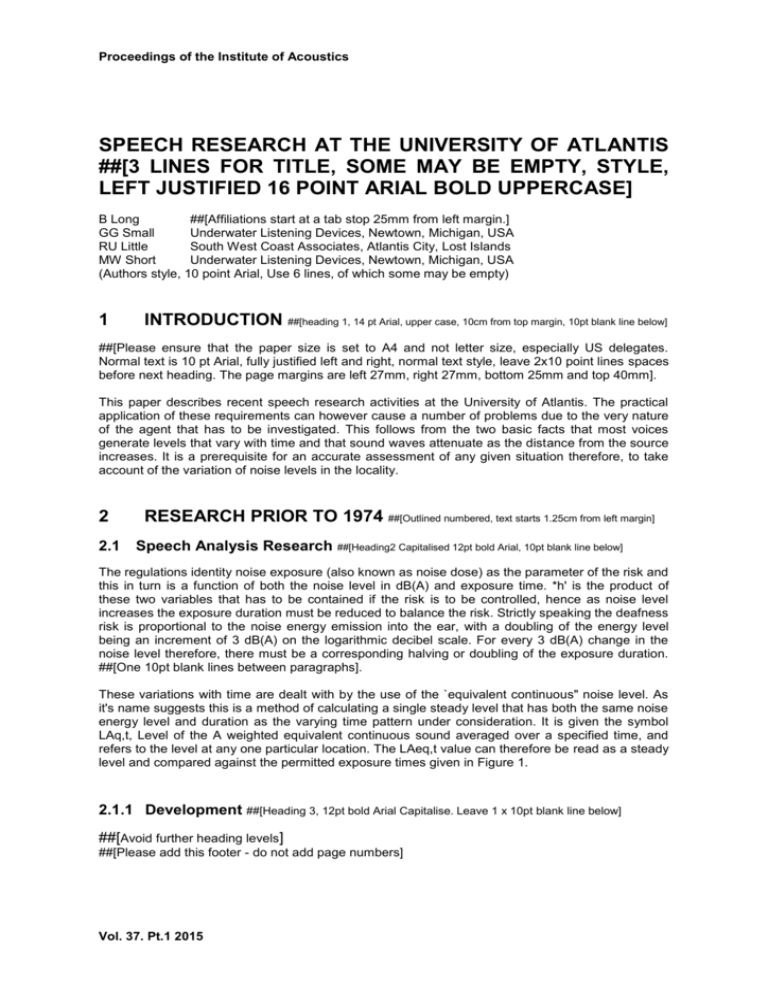
Proceedings of the Institute of Acoustics SPEECH RESEARCH AT THE UNIVERSITY OF ATLANTIS ##[3 LINES FOR TITLE, SOME MAY BE EMPTY, STYLE, LEFT JUSTIFIED 16 POINT ARIAL BOLD UPPERCASE] B Long ##[Affiliations start at a tab stop 25mm from left margin.] GG Small Underwater Listening Devices, Newtown, Michigan, USA RU Little South West Coast Associates, Atlantis City, Lost Islands MW Short Underwater Listening Devices, Newtown, Michigan, USA (Authors style, 10 point Arial, Use 6 lines, of which some may be empty) 1 INTRODUCTION ##[heading 1, 14 pt Arial, upper case, 10cm from top margin, 10pt blank line below] ##[Please ensure that the paper size is set to A4 and not letter size, especially US delegates. Normal text is 10 pt Arial, fully justified left and right, normal text style, leave 2x10 point lines spaces before next heading. The page margins are left 27mm, right 27mm, bottom 25mm and top 40mm]. This paper describes recent speech research activities at the University of Atlantis. The practical application of these requirements can however cause a number of problems due to the very nature of the agent that has to be investigated. This follows from the two basic facts that most voices generate levels that vary with time and that sound waves attenuate as the distance from the source increases. It is a prerequisite for an accurate assessment of any given situation therefore, to take account of the variation of noise levels in the locality. 2 2.1 RESEARCH PRIOR TO 1974 ##[Outlined numbered, text starts 1.25cm from left margin] Speech Analysis Research ##[Heading2 Capitalised 12pt bold Arial, 10pt blank line below] The regulations identity noise exposure (also known as noise dose) as the parameter of the risk and this in turn is a function of both the noise level in dB(A) and exposure time. *h' is the product of these two variables that has to be contained if the risk is to be controlled, hence as noise level increases the exposure duration must be reduced to balance the risk. Strictly speaking the deafness risk is proportional to the noise energy emission into the ear, with a doubling of the energy level being an increment of 3 dB(A) on the logarithmic decibel scale. For every 3 dB(A) change in the noise level therefore, there must be a corresponding halving or doubling of the exposure duration. ##[One 10pt blank lines between paragraphs]. These variations with time are dealt with by the use of the `equivalent continuous" noise level. As it's name suggests this is a method of calculating a single steady level that has both the same noise energy level and duration as the varying time pattern under consideration. It is given the symbol LAq,t, Level of the A weighted equivalent continuous sound averaged over a specified time, and refers to the level at any one particular location. The LAeq,t value can therefore be read as a steady level and compared against the permitted exposure times given in Figure 1. 2.1.1 Development ##[Heading 3, 12pt bold Arial Capitalise. Leave 1 x 10pt blank line below] ##[Avoid further heading levels] ##[Please add this footer - do not add page numbers] Vol. 37. Pt.1 2015 Proceedings of the Institute of Acoustics 3 OTHER STYLE COMMENTS (text starts at 40mm from top of page) ## Do not change the line stating “Proceedings of the Institute of Acoustics”] ##[Figures can be reproduced in colour or black and white as proceedings are produced on CD, but bare in mind that if they use colour, the figures may become unintelligible if photocopied in black and white.] ##[Papers will normally be 8 pages long. You should also provide an abstract of about 200 words to the Institute of Acoustics if you have not already done so.] ##[Papers to be emailed to linda.canty@ioa.org.uk.] ##[Figure should be numbered, e.g. Figure 1, with captions in 10pt Arial] ##[References should be numbered in superscript and appear at the end of the paper 1,2,3 4 REFERENCES 1. H.J.M. Steeneken and T. Houtgast, The temporal envelope spectrum and its significance in room acoustics, Proc. 11th ICA, Vol. 7, 85-88. Paris (1983). T.J. Cox, F. Li and P. Darlington., ‘Extracting room reverberation time from speech using artificial neural networks’, J.Audio.Eng.Soc. 49(4) 219-230. (April 2001). S. Haykin. Neural Networks: A Comprehensive Foundation, 2 nd ed Prentice Hall, 300-314. (1999). ##[Reference list style, text starts at 1.25cm, 10pt Arial] 2. 3. 4. Vol. 37. Pt.1 2015
